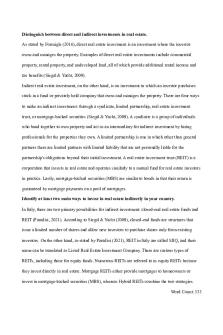Chapter 8 Learning Goals PDF

| Title | Chapter 8 Learning Goals |
|---|---|
| Course | The Solar System |
| Institution | Indiana University - Purdue University Indianapolis |
| Pages | 2 |
| File Size | 59.1 KB |
| File Type | |
| Total Downloads | 40 |
| Total Views | 168 |
Summary
Learning Goals of Chapter 8 from AST-A100...
Description
Chapter 8 8.1 The search for origins How did we arrive at a theory of solar system formation? o A successful theory must explain four major features of our solar system: Patterns of motion, the existence of two types of planets Terrestrial Jovian The presence of asteroids and comets Exceptions to the rules o Developed over a period of more than two centuries, the nebular theory explains all four features and also can account for other planetary systems. Where did the solar system come from? o The nebular theory holds that the solar system formed from the gravitational collapse of an interstellar cloud known as the solar nebula. o The cloud was the product of recycling of gas through many generations of stars within our galaxy. o This material consisted of 98% hydrogen and helium and 2% all other elements combined. 8.2 Explaining the Major features of the solar system What caused the orderly patterns of motion? o As the solar nebula collapsed under gravity, natural processes caused it to heat up, spin faster, and flatten out as it shrank. o The orderly motions we observe today all came from the orderly motion of this spinning disk. Why are there two major types of planets? o The inner regions of the solar nebula were relatively hot, so only metal and rock could condense into tiny solid grains These grains accreted into larger planetesimals that ultimately merged to make the terrestrial planets. o Beyond the frost line, cooler temperatures also allowed more abundant hydrogen compounds to condense into ice, building ice-rich planetesimals Some of these grew large enough for their gravity to draw in hydrogen and helium gas, forming the Jovian planets Where did asteroids and comets come from? o Asteroids are the rocky leftover planetesimals of the inner solar system, and comets are the ice-rich leftover planetesimals of the outer solar system. These objects sill occasionally collide with planets or moons, but the vast majority of impacts occurred during the heavy bombardment in the solar system's first few hundred million years. How do we explain "exceptions to the rules? o Most of the exceptions probably arose from collisions or close encounters with leftover planetesimals. o Our Moon is most likely the result of a giant impact between a Mars-size planetesimal and the young Earth. 8.3 The Age of the Solar System How do we measure the age of a rock?
Radiometric dating is based on carefully measuring the proportions of radioactive isotopes and their decay products within rocks. o The ratio of the isotopes changes with the time in a steady and predictable way that we characterize by an isotope's half-life. The time it takes for half the atoms in a collection to decay. How do we know the age of the solar system? o Radiometric dating of the oldest meteorites tells us that accretion began in the solar nebula about 4.56 billion years ago, with the planets forming by about 4.5 million years ago. o
...
Similar Free PDFs

Chapter 8 Learning Goals
- 2 Pages

Learning Smart Goals
- 2 Pages

MO Early Learning Goals 2019
- 17 Pages

Learning Goals 4h, 4i notes
- 1 Pages

CNP 2 Learning Goals 2019
- 2 Pages

Chapter 7 & 8 Learning Exercises
- 10 Pages

Smart goals chapter 2
- 2 Pages

Learning lec 8 - Dr.Hugo
- 6 Pages

Chapter-8 - chapter 8
- 13 Pages

Learning Journal Unit 8
- 2 Pages

Learning Journal Unit 8
- 2 Pages

BUS2204 - Learning Journal 8
- 2 Pages

Subject Learning Guide 8
- 14 Pages

Learning Stories Week 8
- 6 Pages

Learning Guide Unit 8
- 6 Pages
Popular Institutions
- Tinajero National High School - Annex
- Politeknik Caltex Riau
- Yokohama City University
- SGT University
- University of Al-Qadisiyah
- Divine Word College of Vigan
- Techniek College Rotterdam
- Universidade de Santiago
- Universiti Teknologi MARA Cawangan Johor Kampus Pasir Gudang
- Poltekkes Kemenkes Yogyakarta
- Baguio City National High School
- Colegio san marcos
- preparatoria uno
- Centro de Bachillerato Tecnológico Industrial y de Servicios No. 107
- Dalian Maritime University
- Quang Trung Secondary School
- Colegio Tecnológico en Informática
- Corporación Regional de Educación Superior
- Grupo CEDVA
- Dar Al Uloom University
- Centro de Estudios Preuniversitarios de la Universidad Nacional de Ingeniería
- 上智大学
- Aakash International School, Nuna Majara
- San Felipe Neri Catholic School
- Kang Chiao International School - New Taipei City
- Misamis Occidental National High School
- Institución Educativa Escuela Normal Juan Ladrilleros
- Kolehiyo ng Pantukan
- Batanes State College
- Instituto Continental
- Sekolah Menengah Kejuruan Kesehatan Kaltara (Tarakan)
- Colegio de La Inmaculada Concepcion - Cebu
